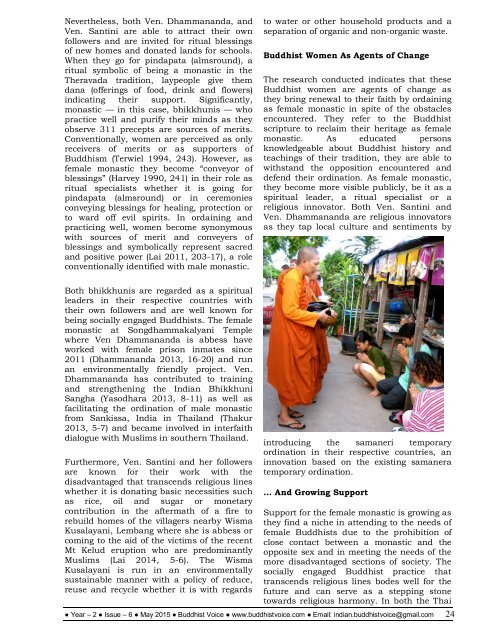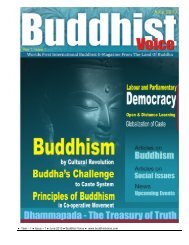BV - May 2015 Yr 2 Issue 6 E
Create successful ePaper yourself
Turn your PDF publications into a flip-book with our unique Google optimized e-Paper software.
Nevertheless, both Ven. Dhammananda, and<br />
Ven. Santini are able to attract their own<br />
followers and are invited for ritual blessings<br />
of new homes and donated lands for schools.<br />
When they go for pindapata (almsround), a<br />
ritual symbolic of being a monastic in the<br />
Theravada tradition, laypeople give them<br />
dana (offerings of food, drink and flowers)<br />
indicating their support. Significantly,<br />
monastic — in this case, bhikkhunis — who<br />
practice well and purify their minds as they<br />
observe 311 precepts are sources of merits.<br />
Conventionally, women are perceived as only<br />
receivers of merits or as supporters of<br />
Buddhism (Terwiel 1994, 243). However, as<br />
female monastic they become “conveyor of<br />
blessings” (Harvey 1990, 241) in their role as<br />
ritual specialists whether it is going for<br />
pindapata (almsround) or in ceremonies<br />
conveying blessings for healing, protection or<br />
to ward off evil spirits. In ordaining and<br />
practicing well, women become synonymous<br />
with sources of merit and conveyers of<br />
blessings and symbolically represent sacred<br />
and positive power (Lai 2011, 203-17), a role<br />
conventionally identified with male monastic.<br />
to water or other household products and a<br />
separation of organic and non-organic waste.<br />
Buddhist Women As Agents of Change<br />
The research conducted indicates that these<br />
Buddhist women are agents of change as<br />
they bring renewal to their faith by ordaining<br />
as female monastic in spite of the obstacles<br />
encountered. They refer to the Buddhist<br />
scripture to reclaim their heritage as female<br />
monastic. As educated persons<br />
knowledgeable about Buddhist history and<br />
teachings of their tradition, they are able to<br />
withstand the opposition encountered and<br />
defend their ordination. As female monastic,<br />
they become more visible publicly, be it as a<br />
spiritual leader, a ritual specialist or a<br />
religious innovator. Both Ven. Santini and<br />
Ven. Dhammananda are religious innovators<br />
as they tap local culture and sentiments by<br />
Both bhikkhunis are regarded as a spiritual<br />
leaders in their respective countries with<br />
their own followers and are well known for<br />
being socially engaged Buddhists. The female<br />
monastic at Songdhammakalyani Temple<br />
where Ven Dhammananda is abbess have<br />
worked with female prison inmates since<br />
2011 (Dhammananda 2013, 16-20) and run<br />
an environmentally friendly project. Ven.<br />
Dhammananda has contributed to training<br />
and strengthening the Indian Bhikkhuni<br />
Sangha (Yasodhara 2013, 8-11) as well as<br />
facilitating the ordination of male monastic<br />
from Sankissa, India in Thailand (Thakur<br />
2013, 5-7) and became involved in interfaith<br />
dialogue with Muslims in southern Thailand.<br />
Furthermore, Ven. Santini and her followers<br />
are known for their work with the<br />
disadvantaged that transcends religious lines<br />
whether it is donating basic necessities such<br />
as rice, oil and sugar or monetary<br />
contribution in the aftermath of a fire to<br />
rebuild homes of the villagers nearby Wisma<br />
Kusalayani, Lembang where she is abbess or<br />
coming to the aid of the victims of the recent<br />
Mt Kelud eruption who are predominantly<br />
Muslims (Lai 2014, 5-6). The Wisma<br />
Kusalayani is run in an environmentally<br />
sustainable manner with a policy of reduce,<br />
reuse and recycle whether it is with regards<br />
introducing the samaneri temporary<br />
ordination in their respective countries, an<br />
innovation based on the existing samanera<br />
temporary ordination.<br />
… And Growing Support<br />
Support for the female monastic is growing as<br />
they find a niche in attending to the needs of<br />
female Buddhists due to the prohibition of<br />
close contact between a monastic and the<br />
opposite sex and in meeting the needs of the<br />
more disadvantaged sections of society. The<br />
socially engaged Buddhist practice that<br />
transcends religious lines bodes well for the<br />
future and can serve as a stepping stone<br />
towards religious harmony. In both the Thai<br />
● Year – 2 ● <strong>Issue</strong> – 6 ● <strong>May</strong> <strong>2015</strong> ● Buddhist Voice ● www.buddhistvoice.com ● Email: indian.buddhistvoice@gmail.com 24



